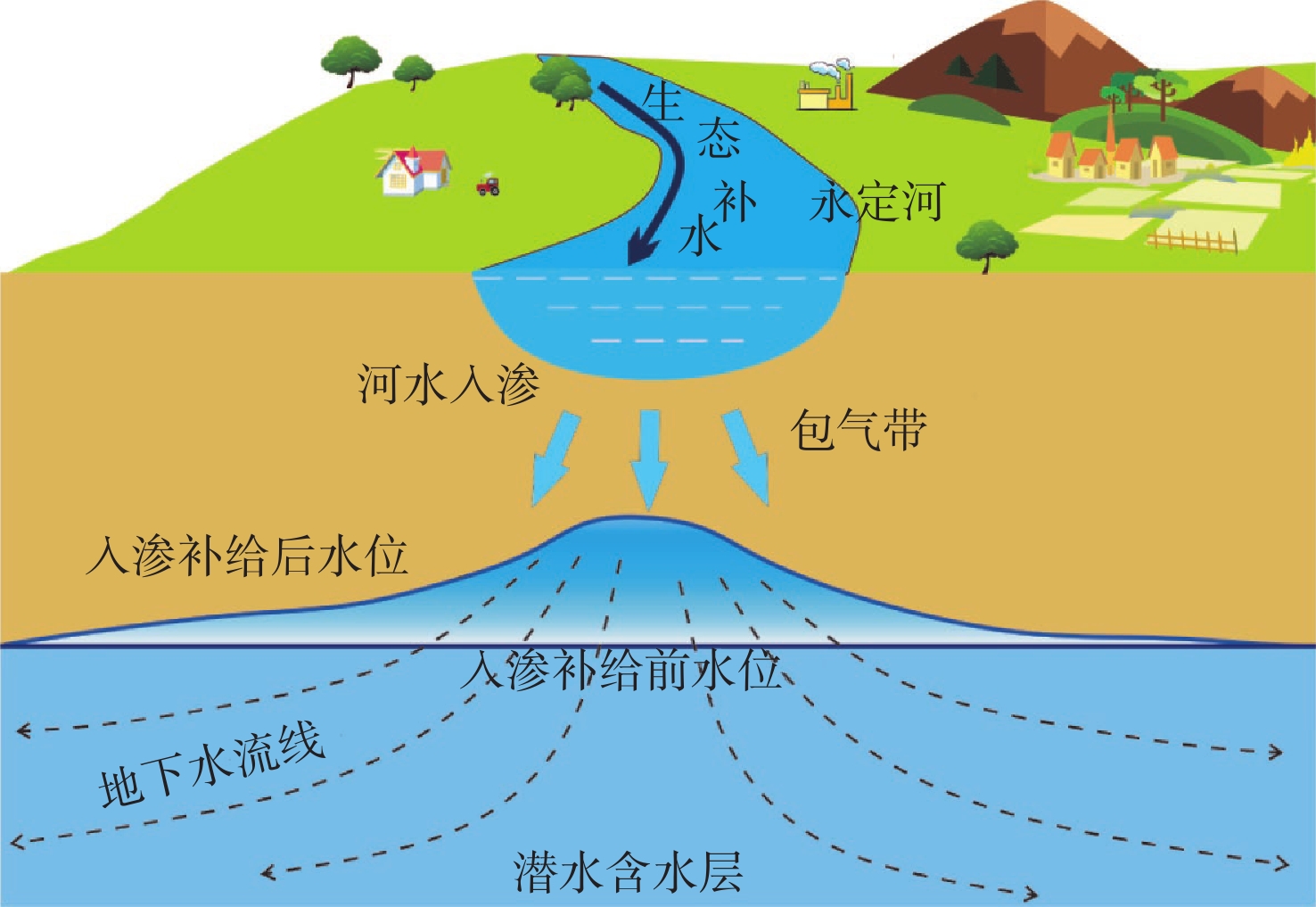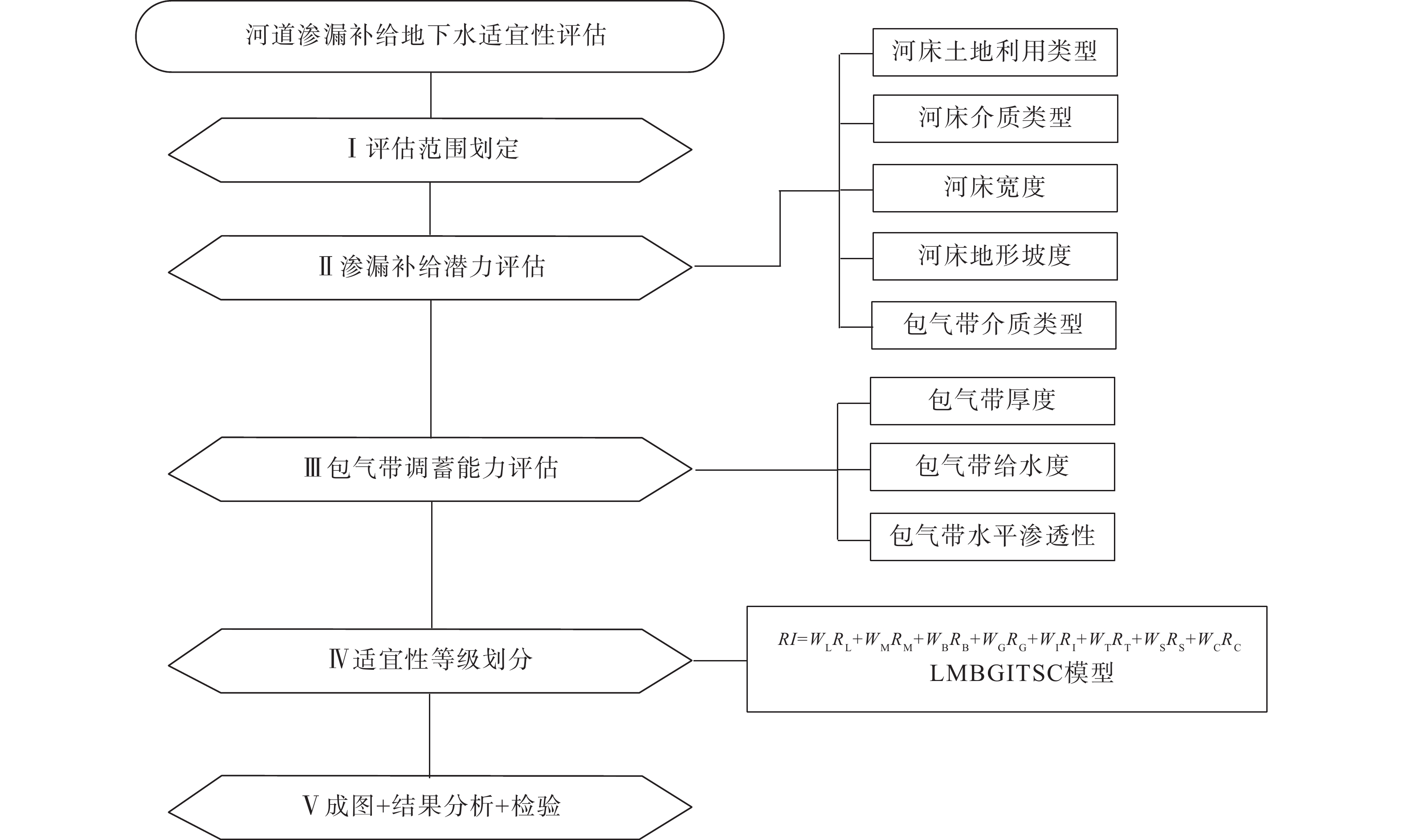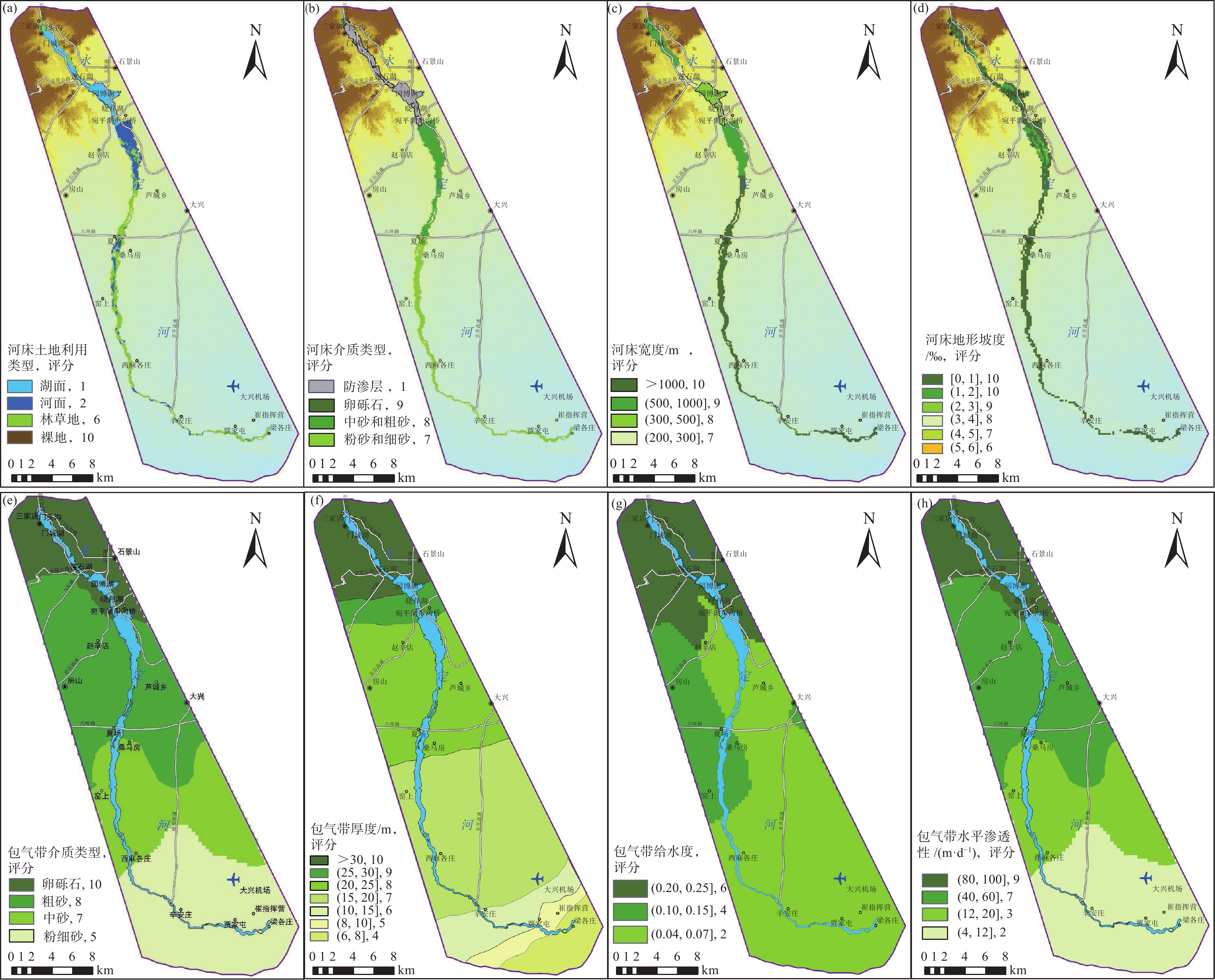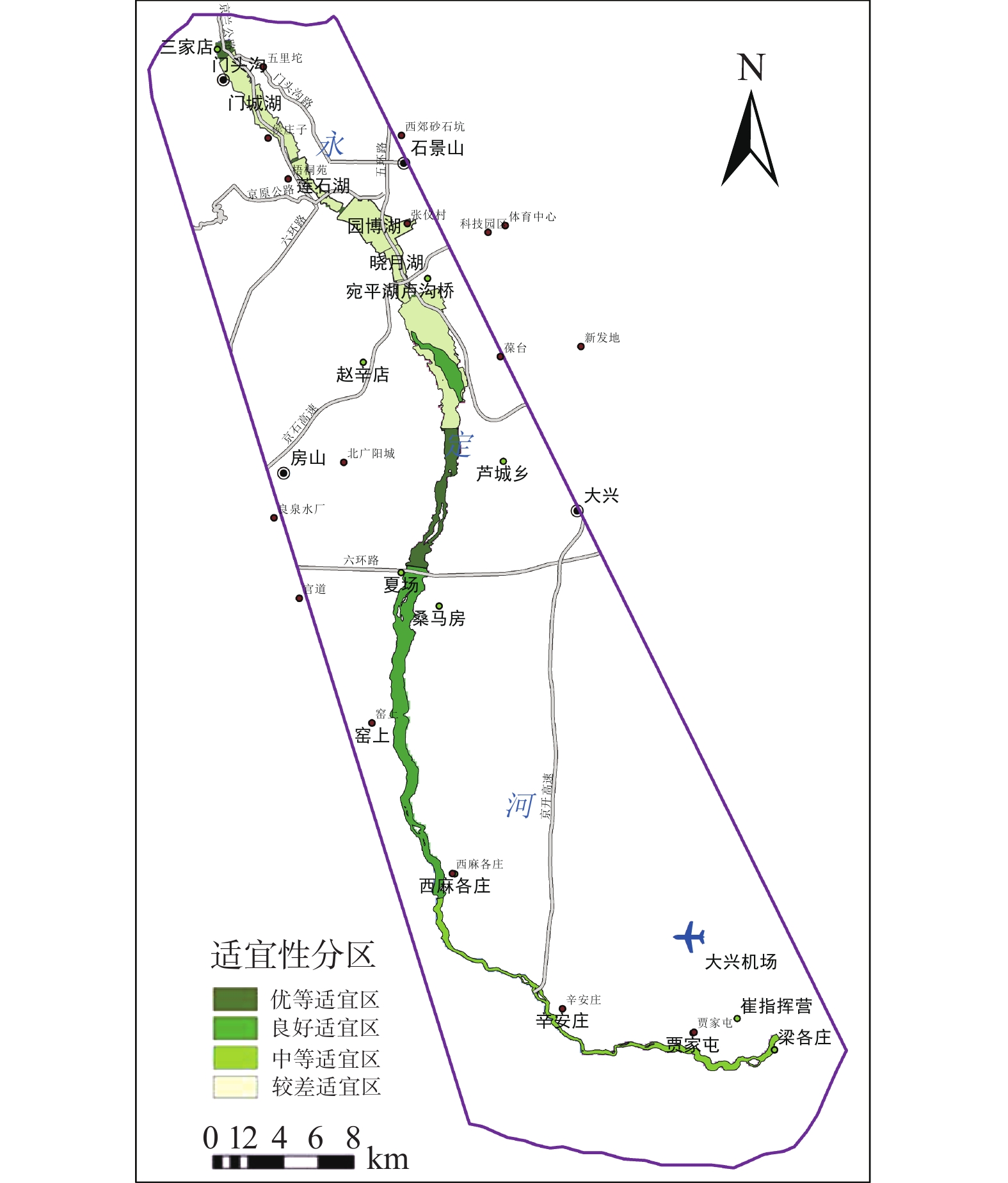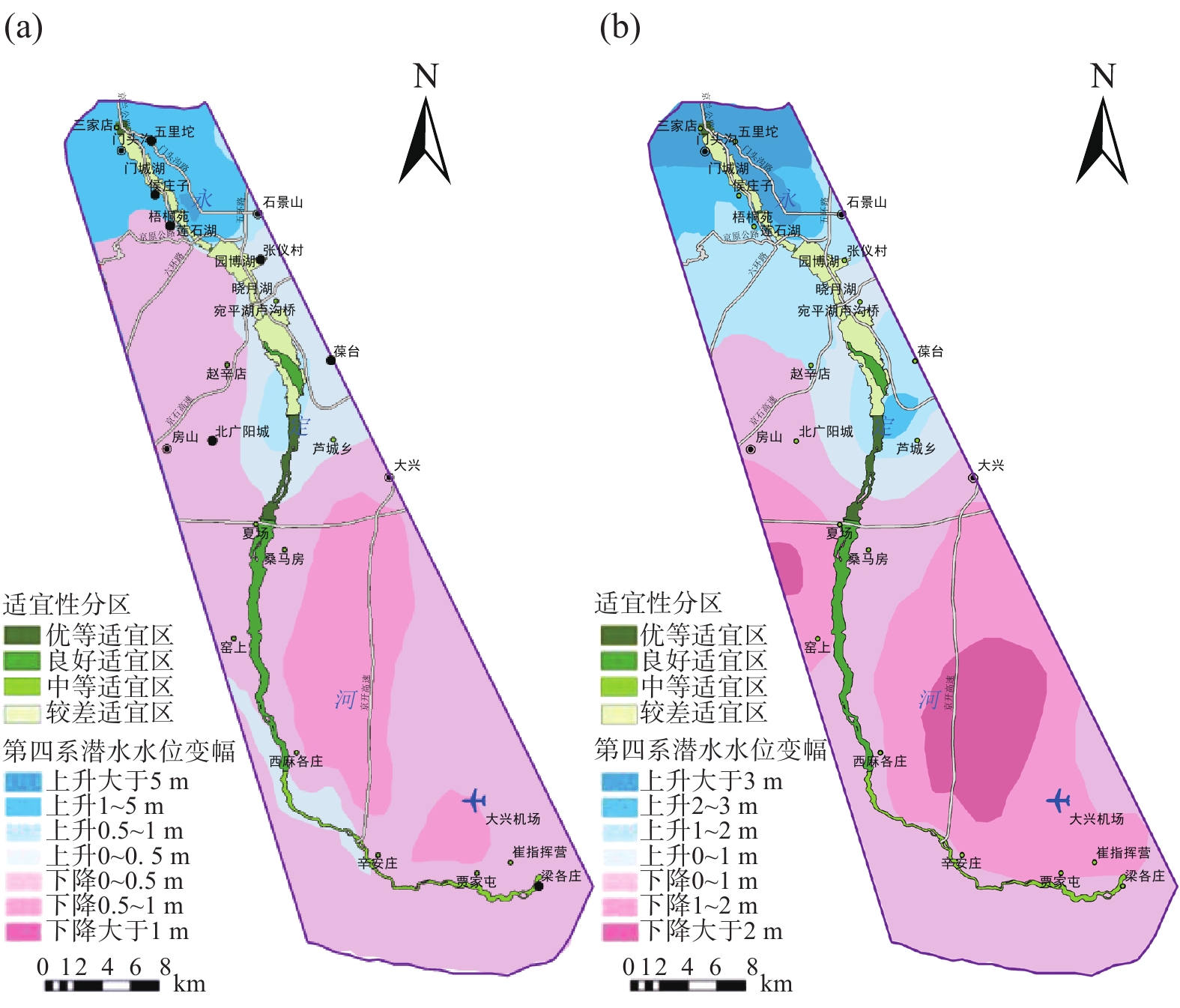The suitability assessment of groundwater recharge by leakage of the Yongding River
-
摘要:
受气候变化和人类活动等因素的综合影响,地下水超采和含水层水量亏空已成为备受关注的全球性问题。为了弥补含水层水量亏空和促进地下水资源涵养,已探索出多种人为干预地下水补给的措施,其中通过河道开展地下水人工补给由于具有明显优势而受到重视。已有实践表明,受渗漏补给潜力和包气带调蓄能力等的限制,并不是所有河流或河段都适宜开展地下水人工补给工作。目前缺乏为大家广泛接受的适宜性评估方法。本研究以永定河生态补水为契机,以北京平原段河道和下伏含水层为研究区开展了案例研究,并用实测数据对研究结果进行了检验。应用指标体系法建立的适宜性评估模型(LMBGITSC模型)包括河床土地利用类型、河床介质类型、河床宽度、河床地形坡度、包气带介质类型、包气带厚度、包气带给水度、包气带水平渗透性等8个指标。案例研究结果表明,沿河流流向,通过河道渗漏补给地下水的适宜性由好变差(防渗河段除外)。该规律主要受渗漏补给潜力和包气带调蓄能力控制,因此适宜性也呈现出“阶梯式”演变规律。检验结果表明所建的评估方法适用性较好。该方法具有可移植性,因此也可为其他同类地区提供参考。
Abstract:Due to the effect of climate changes and human activities, groundwater over-exploitation and aquifer depletion have become global issues of concern. Artificial recharge of groundwater through a river has been paid more attention among a variety of artificial intervention measures. It is found that not all rivers or river reaches are suitable for artificial recharge of groundwater owing to the limitations of recharge potential by infiltration and storage capacity of the vadose zone. At present, there is still a lack of widely accepted suitability assessment methods. In this study, the Yongding River in the Beijing Plain section and the underlying aquifer are taken as the study area and the case study is carried out. Moreover, the measured data are used to verify the results. The suitability assessment model (LMBGITSC model) constructed by the index system method includes eight indexes: land use types of riverbed, sediment types of riverbed, channel width, channel topographic slope, medium types of the vadose zone, thickness of the vadose zone, specific yield of the vadose zone and horizontal permeability of the vadose zone. The results show that the suitability of groundwater recharge in the Yongding River changes from good degree to medium degree along the river flow direction (except the reaches carried out anti-seepage engineering), presenting a "step-type" evolution law. The proposed method is of good applicability and can also provide reference for similar regions.
-

-
图 6 补水开始一个月后(a)和两个月后(b)的地下水位变幅(改编自文献[19])
Figure 6.
表 1 通过河道渗漏补给地下水适宜性评估指标的等级划分和各等级评分
Table 1. Classification and grading of the suitability assessment indexes of groundwater recharge by leakage of a river
指标评分 河床土地利用
类型(L)河床介质类型
(M)河床宽度
(B)/m河床地形坡度
(G)/‰包气带介质
类型(I)包气带厚度
(T)/m包气带给水度
(S)包气带水平渗透性
(C)/(m·d−1)1 已硬化段 非涨缩和非凝聚性黏土(岩石) ≤10 >10 黏土 ≤2 ≤0.04 [0,4] 2 水域 黏质壤土(黏土) (10,20] (9,10] 亚黏土 (2,4] (0.04,0.07] (4,12] 3 — 粉质壤土 (20,50] (8,9] 亚砂土 (4,6] (0.07,0.10] (12,20] 4 — 壤土 (50,100] (7,8] 粉砂 (6,8] (0.10,0.15] (20,30] 5 — 砂质壤土(砂土) (100,150] (6,7] 粉细砂 (8,10] (0.15,0.20] (30,35] 6 林草地 胀缩或凝聚性黏土 (150,200] (5,6] 细砂 (10,15] (0.20,0.25] (35,40] 7 — 粉砂和细砂 (200,300] (4,5] 中砂 (15,20] (0.25,0.30] (40,60] 8 — 砾石/中砂和粗砂 (300,500] (3,4] 粗砂 (20,25] (0.30,0.35] (60,80] 9 — 卵砾石 (500,1000] (2,3] 砂砾石 (25,30] (0.35,0.40] (80,100] 10 裸地 河床薄或缺失 >1000 [0,2] 卵砾石 >30 >0.40 >100 注:—表示无量纲或无相应的指标类别;包气带水平渗透性指饱和渗透性。 表 2 准则层权重矩阵
Table 2. Weight matrix of the criterion layer
评估指标 B1 B2 B1 1 3 B2 1/3 1 表 3 B1-C权重矩阵
Table 3. Weight matrix of B1-C
评估指标 C1 C2 C3 C4 C5 C1 1 3 7 9 3 C2 1/3 1 3 5 1 C3 1/7 1/3 1 3 1/5 C4 1/9 1/5 1/3 1 1/7 C5 1/3 1 5 7 1 表 4 B2-C权重矩阵
Table 4. Weight matrix of B2-C
评估指标 C6 C7 C8 C6 1 3 1/3 C7 1/3 1 1/5 C8 3 5 1 表 5 各评估指标权重
Table 5. Weights of each evaluation index
评估指标 权重 C1 0.365 C2 0.141 C3 0.050 C4 0.026 C5 0.168 C6 0.065 C7 0.026 C8 0.159 表 6 通过河道补水渗漏补给地下水的适宜性分级
Table 6. Classification of the suitability of groundwater recharge by leakage of a river
适宜性指数RI 等级 适宜性评估 8~10分 I级 优等适宜区 7~8分 II级 良好适宜区 6~7分 III级 中等适宜区 5~6分 IV级 较差适宜区 <5分 V级 最差适宜区 -
[1] 郭海朋, 李文鹏, 王丽亚, 等. 华北平原地下水位驱动下的地面沉降现状与研究展望[J]. 水文地质工程地质,2021,48(3):162 − 171. [GUO Haipeng, LI Wenpeng, WANG Liya, et al. Present situation and research prospects of the land subsidence driven by groundwater levels in the North China Plain[J]. Hydrogeology & Engineering Geology,2021,48(3):162 − 171. (in Chinese with English abstract)
[2] DILLON P, PAGE D, VANDERZALM J, et al. A critical evaluation of combined engineered and aquifer treatment systems in water recycling[J]. Water Science and Technology,2008,57(5):753 − 762. doi: 10.2166/wst.2008.168
[3] JASECHKO S, SEYBOLD H, PERRONE D, et al. Widespread potential loss of streamflow into underlying aquifers across the USA[J]. Nature,2021,591(7850):391 − 395. doi: 10.1038/s41586-021-03311-x
[4] 费宇红, 崔广柏. 地下水人工调蓄研究进展与问题[J]. 水文,2006,26(4):10 − 14. [FEI Yuhong, CUI Guangbo. Development and problems: research on artificial adjustment of groundwater storage[J]. Journal of China Hydrology,2006,26(4):10 − 14. (in Chinese with English abstract) doi: 10.3969/j.issn.1000-0852.2006.04.003
[5] YIN W, TENG Y, ZHAI Y, et al. Suitability for developing riverside groundwater sources along Songhua River, Northeast China[J]. Human and Ecological Risk Assessment: An International Journal,2018,24(8):2088 − 2100. doi: 10.1080/10807039.2018.1438174
[6] WANG L, YE X, DU X. Suitability evaluation of river bank filtration along the Second Songhua River, China[J]. Water,2016,8(5):176. doi: 10.3390/w8050176
[7] 王兆庚, 郭祺忠, 练继建, 等. 建筑屋面雨水有压回补地下水理念与潜力评估[J]. 水利学报,2019,50(8):999 − 1009. [WANG Zhaogeng, GUO Qizhong, LIAN Jijian, et al. Concept and assessment of utilizing rooftop rainwater for pressurized groundwater recharge[J]. Journal of Hydrology Engineering,2019,50(8):999 − 1009. (in Chinese with English abstract)
[8] GHAZAVI R, BABAEI S, ERFANIAN M. Recharge wells site selection for artificial groundwater recharge in an urban area using fuzzy logic technique[J]. Water Resources Management,2018,32(12):3821 − 3834. doi: 10.1007/s11269-018-2020-7
[9] DILLON P, STUYFZAND P, GRISCHEK T, et al. Sixty years of global progress in managed aquifer recharge[J]. Hydrogeology Journal,2019,27(1):1 − 30. doi: 10.1007/s10040-018-1841-z
[10] 席海洋, 冯起, 司建华, 等. 黑河下游额济纳三角洲河道渗漏对地下水补给研究综述[J]. 冰川冻土,2012,34(5):1241 − 1247. [XI Haiyang, FENG Qi, SI Jianhua, et al. A review of river course leakage in the Ejina delta in the lower reaches of Heihe River[J]. Journal of Glaciology and Geocryology,2012,34(5):1241 − 1247. (in Chinese with English abstract)
[11] 杨小芳, 王明玉, 王丽亚, 等. 永定河生态修复地下水位主控因素与数值模拟预测不确定性[J]. 中国科学院大学学报,2015,32(2):192 − 199. [YANG Xiaofang, WANG Mingyu, WANG Liya, et al. Investigation of key controlling factors and numerical simulation uncertainty of the groundwater level companying with Yongding river ecological restoration[J]. Journal of University of Chinese Academy of Sciences,2015,32(2):192 − 199. (in Chinese with English abstract) doi: 10.7523/j.issn.2095-6134.2015.02.007
[12] BOUWER H. Artificial recharge of groundwater: hydrogeology and engineering[J]. Hydrogeology Journal,2002,10(1):121 − 142. doi: 10.1007/s10040-001-0182-4
[13] 束龙仓, 陶玉飞, 刘佩贵. 考虑水文地质参数不确定性的地下水补给量可靠度计算[J]. 水利学报,2008,39(3):346 − 350. [SHU Longcang, TAO Yufei, LIU Peigui. Reliability calculation method for groundwater recharge in consideration of uncertainty of hydrogeological parameters[J]. Journal of Hydrology Engineering,2008,39(3):346 − 350. (in Chinese with English abstract) doi: 10.3321/j.issn:0559-9350.2008.03.014
[14] 王诏楷, 束龙仓, 刘波, 等. 孔隙结构对地下水回灌颗粒堵塞影响的试验研究[J]. 水利学报,2021,52(4):498 − 506. [WANG Zhaokai, SHU Longcang, LIU Bo, et al. Experimental research on the effects of pore structure on particle clogging of groundwater recharge[J]. Journal of Hydrology Engineering,2021,52(4):498 − 506. (in Chinese with English abstract)
[15] 钟媛媛. 汾河上游河道渗漏对晋祠泉域岩溶地下水影响的数值模拟研究[D]. 太原: 太原理工大学, 2017.
ZHONG Yuanyuan. Numerical simulation research on influence of channel leakage in Fenhe River upstearm on karst groundwater in Jinci Spring catchment [D]. Taiyuan: Taiyuan University of Technology, 2017. (in Chinese with English abstract
[16] 张广朋. 塔里木河干流上中游河床沉积物渗透系数及渗漏水量研究[D]. 乌鲁木齐: 新疆农业大学, 2016.
ZHANG Guangpeng. Study on hydraulic conductivity of riverbed sediment and leakage water in upper and middle stream of Tarim River [D]. Urumqi: Xinjiang Agricultural University, 2016. (in Chinese with English abstract
[17] 马尧, 杨勇, 胡国金, 等. 永定河(北京段)生态补水对地下水的补给分析[J]. 北京水务,2020(4):22 − 27. [MA Yao, YANG Yong, HU Guojin, et al. Analysis of groundwater recharge by ecological water supply project in Yongding River (Beijing Section)[J]. Beijing Water,2020(4):22 − 27. (in Chinese with English abstract)
[18] 胡立堂, 郭建丽, 张寿全, 等. 永定河生态补水的地下水位动态响应[J]. 水文地质工程地质,2020,47(5):5 − 11. [HU Litang, GUO Jianli, ZHANG Shouquan, et al. Response of groundwater regime to ecological water replenishment of the Yongding River[J]. Hydrogeology & Engineering Geology,2020,47(5):5 − 11. (in Chinese with English abstract)
[19] 李海军, 崔一娇, 任永强, 等. 永定河2020年春季生态补水对北京地下水涵养效果分析[J]. 城市地质,2021,16(2):133 − 138. [LI Haijun, CUI Yijiao, REN Yongqiang, et al. Analysis on the effect of ecological water replenishment of Yongding River in spring 2020 on groundwater conservation in Beijing[J]. Urban Geology,2021,16(2):133 − 138. (in Chinese with English abstract) doi: 10.3969/j.issn.1007-1903.2021.02.002
[20] 张景华, 李世君, 李阳, 等. 北京地下水库建库条件及可利用库容初步分析[J]. 城市地质,2017,12(1):70 − 76. [ZHANG Jinghua, LI Shijun, LI Yang, et al. Analysis of construction conditions and available storage capacity of the underground reservoir in Beijing basin[J]. Urban Geology,2017,12(1):70 − 76. (in Chinese with English abstract) doi: 10.3969/j.issn.1007-1903.2017.01.012
[21] 王立发, 邢国章, 江剑, 等. 北京市永定河地下水库水资源储蓄能力研究[J]. 城市地质,2013,8(1):18 − 22. [WANG Lifa, XING Guozhang, JIANG Jian, et al. Study on the infiltration and the storage capability of artificial adjustment on the Yongding River groundwater reservoir in Beijing[J]. Urban Geology,2013,8(1):18 − 22. (in Chinese with English abstract) doi: 10.3969/j.issn.1007-1903.2013.01.004
[22] 王槿妍, 王材源, 刘翠珠, 等. 永定河生态补水水文要素变化分析[J]. 北京水务,2020(4):28 − 31. [WANG Jinyan, WANG Caiyuan, LIU Cuizhu, et al. Analysis on changes of hydrological elements of ecological water supply project in Yongding River[J]. Beijing Water,2020(4):28 − 31. (in Chinese)
[23] 杨勇, 谷健芬, 李元春. 永定河长时放水条件下的入渗能力及影响范围分析[J]. 工程勘察,2019,47(6):29 − 35. [YANG Yong, GU Jianfen, LI Yuanchun. Analysis on infiltration capacity and influence range of Yongding River under the condition of long-time discharge[J]. Geotechnical Investigation & Surveying,2019,47(6):29 − 35. (in Chinese with English abstract)
[24] ZHAI Y, GUO Y, ZHOU J, et al. The spatio-temporal variability of annual precipitation and its local impact factors during 1724-2010 in Beijing, China[J]. Hydrological Processes,2014,28(4):2192 − 2201. doi: 10.1002/hyp.9772
[25] 翟远征, 王金生. 北京市平原区地下水动态要素的时间变化及其启示[J]. 水利学报,2012,43(9):1034 − 1041. [ZHAI Yuanzheng, WANG Jinsheng. Temporal variations of elements of groundwater regime in Beijing Plain and its implications[J]. Journal of Hydrology Engineering,2012,43(9):1034 − 1041. (in Chinese with English abstract)
[26] 翟远征, 王金生, 郇环, 等. 北京市平原区地下水更新能力变化的动态均衡证据[J]. 吉林大学学报(地球科学版),2012(1):198 − 205. [ZHAI Yuanzheng, WANG Jinsheng, HUAN Huan, et al. Groundwater dynamic equilibrium evidence for changes of renewability of groundwater in Beijing Plain[J]. Journal of Jilin University (Earth Science Edition),2012(1):198 − 205. (in Chinese with English abstract)
[27] 中国地质调查局. 地下水脆弱性评估技术要求: GWI-D3[S]. 北京: 中国标准出版社, 2006.
China Geological Survey. Technical requirements for groundwater vulnerability assessment: GWI-D3 [S]. Beijing: Standards Press of China, 2006. (in Chinese)
[28] 徐晓敏. 层次分析法的运用[J]. 统计与决策,2008(1):156 − 158. [XU Xiaomin. The application of analytic hierarchy Process[J]. Statistics & Decision,2008(1):156 − 158. (in Chinese)
[29] 芦红, 王丽, 杨鑫鑫, 等. 水力压裂对地下水影响的深部脆弱性评估[J]. 地球科学,2019,44(9):2920 − 2930. [LU Hong, WANG Li, YANG Xinxin, et al. Deep vulnerability assessment of hydraulic fracturing effect on groundwater[J]. Earth Science,2019,44(9):2920 − 2930. (in Chinese with English abstract)
[30] SUN K, HU L, GUO J, et al. Enhancing the understanding of hydrological responses induced by ecological water replenishment using improved machine learning models: A case study in Yongding River[J]. Science of he Total Environment,2021,768(7):145489.
-



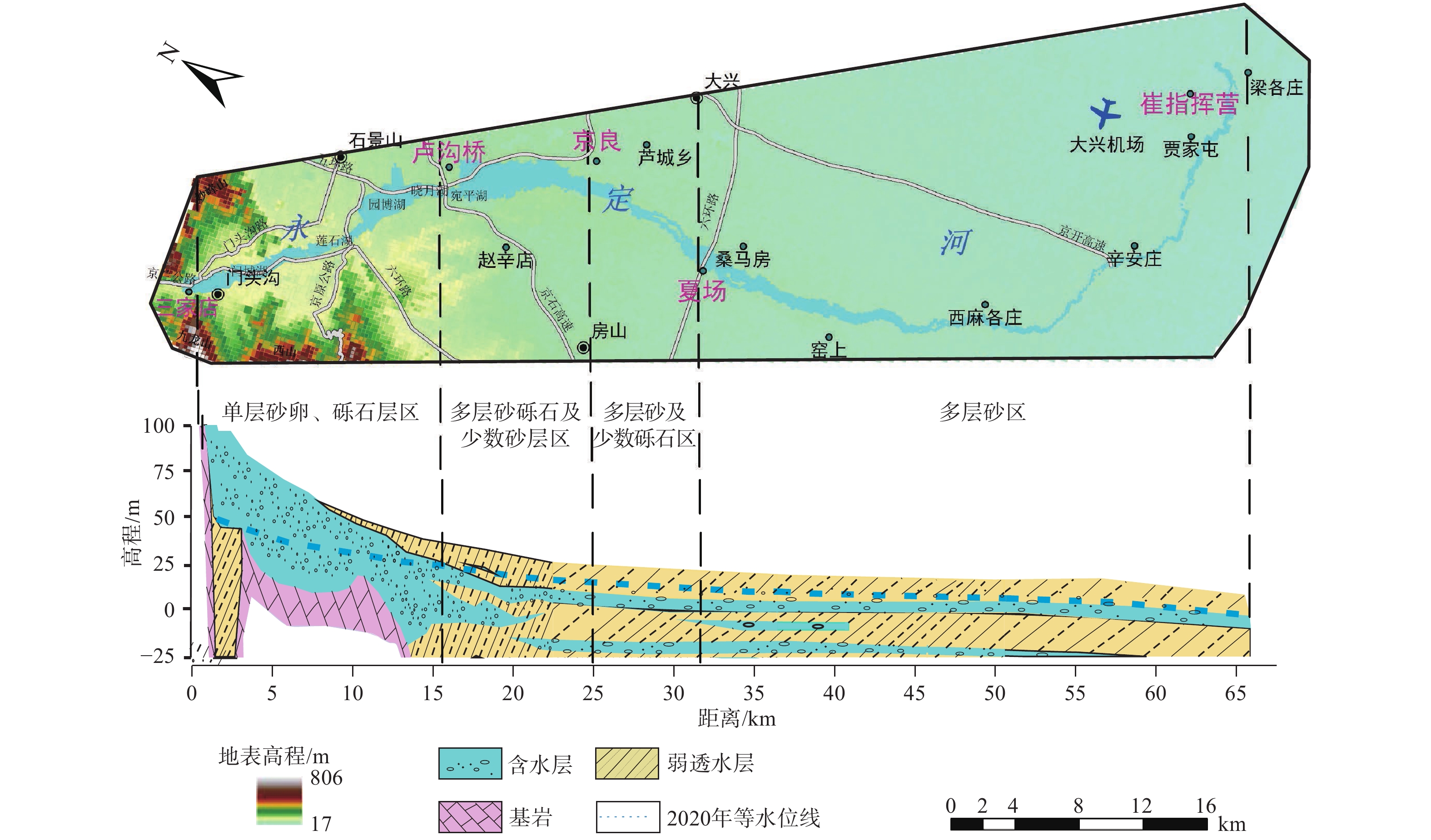
 下载:
下载:
